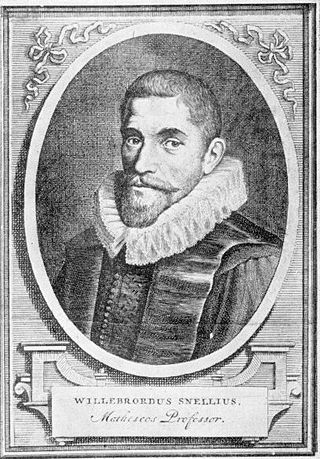Top Qs
Timeline
Chat
Perspective
Willebrord Snellius
Dutch astronomer and mathematician (1580-1626) From Wikipedia, the free encyclopedia
Remove ads
Willebrord Snellius[1][2] (born Willebrord Snel van Royen[3] (13 June 1580[4] – 30 October 1626), commonly known simply as Snellius and Snell, was a Dutch astronomer and mathematician.
You can help expand this article with text translated from the corresponding article in Dutch. (August 2021) Click [show] for important translation instructions.
|
Snell is best known for the law of refraction of light known as Snell's law, his pioneering work in survey known as Snellius's triangulation, and the Snellius–Pothenot problem, a means in planar trigonometry of finding an unknown point from known ones.
Despite being commonly attributed to Snell, the law of refraction was discovered by the Persian scientist Ibn Sahl around 984 AD.[5]
Remove ads
Early life
Willebrord Snellius was born in Leiden, Netherlands. In 1613 he succeeded his father, Rudolph Snel van Royen (1546–1613) as professor of mathematics at the University of Leiden.[6]
Surveying
Summarize
Perspective



In 1615, Snellius, became the first known surveyor since Eratosthenes in 3rd century BC Ptolemaic Egypt to use triangulation to make a large-scale arc measurement to determine the Earth's circumference.[7][8]
In his work The terrae Ambitus vera quantitate (1617) under the author's name ("The Dutch Eratosthenes") Snellius describes achieving his result by calculating the distances between a number of high points in the plain west and southwest of the Netherlands using triangulation. By necessity Snellius's high points were nearly all church spires, virtually the only tall buildings at that time in the west of the Netherlands. More or less ordered from north to south and/or in successive order of measuring, Snellius used a network of fourteen measure points to make a total of 53 triangulation measurements.
These cities were: Alkmaar: St. Laurenskerk; Haarlem: Sint-Bavokerk; Leiden: a then new part (built in 1599) of the city walls;[9] The Hague: Sint-Jacobskerk; Amsterdam: Oude Kerk; Utrecht: Cathedral of Utrecht; Zaltbommel: Sint-Maartenskerk; Gouda: Sint Janskerk; Oudewater: Sint-Michaelskerk; Rotterdam: Sint-Laurenskerk; Dordrecht: Grote Kerk; Willemstad: Koepelkerk; Bergen-op-Zoom: Gertrudiskerk; Breda: Grote Kerk.
Snellius was helped in measuring by two of his students, the Austrian barons Erasmus and Casparus Sterrenberg. In several cities he also received support of friends among the civic leaders (regenten).[citation needed]
In order to carry out these measurements accurately Snellius had a large quadrant built, with which he could accurately measure angles in tenths of degrees. This instrument can still be seen in the Museum Boerhaave in Leiden. In his calculations Snellius made use of a solution for what is now called the Snellius–Pothenot problem.
He came up with an estimate of 28,500 Rhineland rods – in modern units 107.37 km[10] for one degree of latitude. 360 times 107.37 then gives a circumference of the Earth of 38,653 km. The actual circumference is 40,075 kilometers, making Snellius' estimate 3.5% low.
Remove ads
Mathematics and physics
Snellius was also a distinguished mathematician, producing a new method for calculating π—the first such improvement since ancient times. He discovered the law of refraction in 1621.[11]
Other works

In addition to the Eratosthenes Batavus, he published Cyclometricus, de circuli dimensione (1621), and Tiphys Batavus (1624). He also edited Coeli et siderum in eo errantium observationes Hassiacae (1618), containing the astronomical observations of Landgrave William IV of Hesse. A work on trigonometry (Doctrina triangulorum) authored by Snellius was published a year after his death.[6]
Remove ads
Death

Snellius died in Leiden in October 1626, at the age of 46 from an illness diagnosed as colic.[12] His grave can be seen in the Pieterskerk, Leiden.
Legacy
Snellius Glacier in Antarctica is named after Willebrord Snellius.
The lunar crater Snellius is named after Willebrord Snellius.
The Royal Netherlands Navy has named three survey ships after Snellius, including a currently-serving vessel.
Works
- Eratosthenes Batavus (in Latin). Lugduni Batavorum: Joost van Colster, Joris Abrahamsz van der Marsce. 1617.
- Coeli et siderum in eo errantium observationes Hassicae (in Latin). Lugduni Batauorum: Joost van Colster. 1618.
- Cyclometricus (in Latin). Lugduni Batavorum: Matthijs Elzevier, Bonaventura Elzevier. 1621.
- Doctrinae triangulorum canonicae libri quatuor (in Latin). Lugduni Batavorum: Joannes Maire. 1627.
Remove ads
See also
- Area of a circle – Concept in geometry
Notes
References
External links
Wikiwand - on
Seamless Wikipedia browsing. On steroids.
Remove ads

